Szilas A.P. Production and transport of oil and gas, Gathering and Transportation
Подождите немного. Документ загружается.

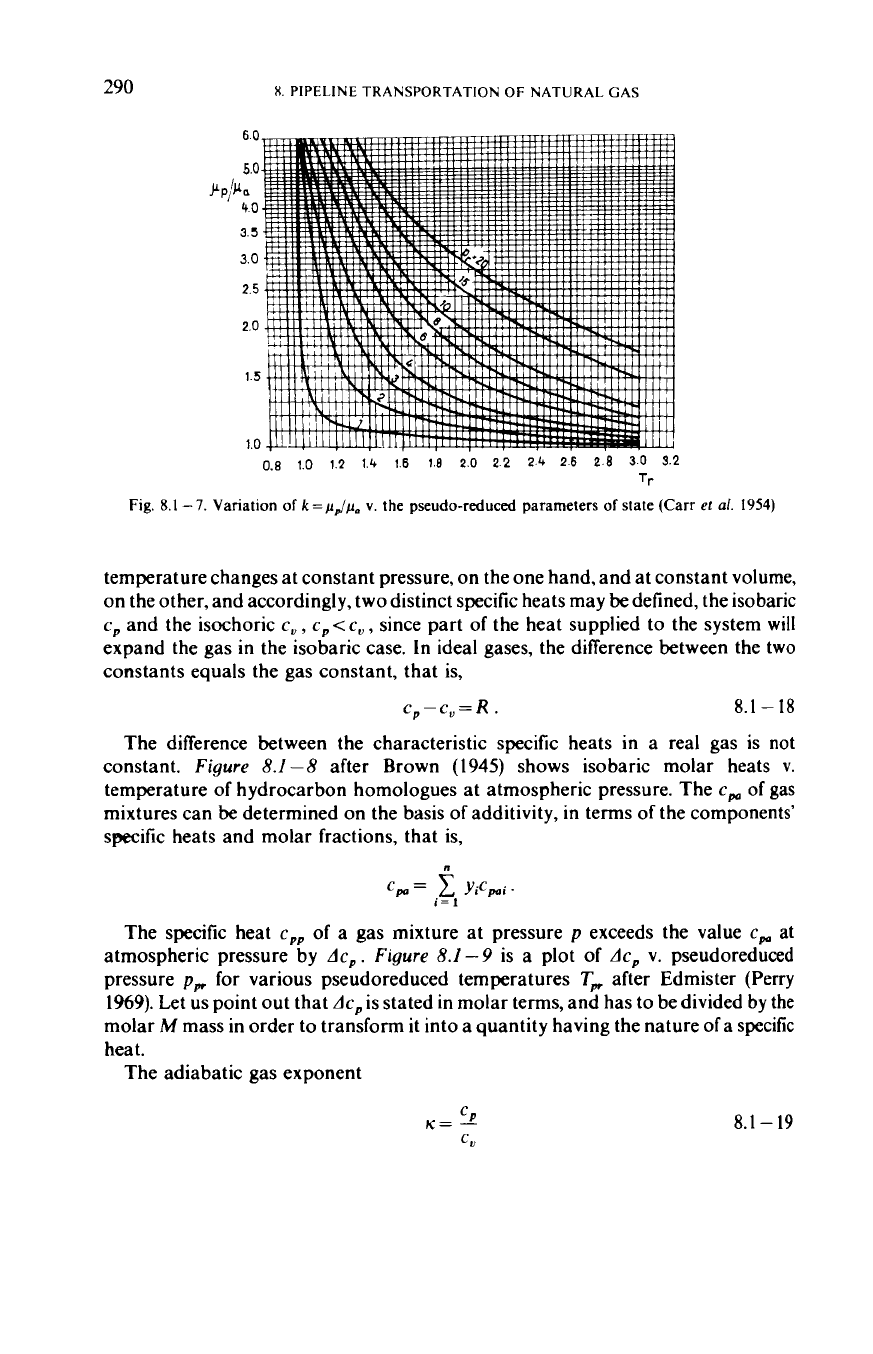
290
X.
PIPELINE TRANSPORTATION
OF
NATURAL GAS
0.8
10
12
14
16
ia
20
22
24
26
28
30
32
Tr
Flg
8
1-7
Vanation
of
k=pdp(.
v
the pseudo-reduced parameters
of
state (Carr
et
a1
1954)
temperature changes at constant pressure, on the one hand, and at constant volume,
on the other, and accordingly, two distinct specific heats may be defined, the isobaric
c,
and the isochoric
c,
,
c,
<
c,
,
since part of the heat supplied to the system
will
expand the gas in the isobaric case. In ideal gases, the difference between the two
constants equals the gas constant, that is,
c~-c,=
R.
8.1
-
18
The difference between the characteristic specific heats in a real gas is not
constant.
Figure
8.1
-8
after Brown
(1945)
shows isobaric molar heats
v.
temperature of hydrocarbon homologues at atmospheric pressure. The
c,
of gas
mixtures can be determined on the basis of additivity, in terms of the components’
specific heats and molar fractions, that is,
cp=
2
yicpi
i=
1
The specific heat
cpp
of
a gas mixture at pressure
p
exceeds the value
c,
at
atmospheric pressure by
Ac,
.
Figure
8.1
-9
is a plot of
Ac,
v. pseudoreduced
pressure
pp
for various pseudoreduced temperatures
T,
after Edmister (Perry
1969).
Let us point out that
Ac,
is stated in molar terms, and has
to
be divided by
the
molar
M
mass in order to transform it into a quantity having the nature of a specific
heat.
The adiabatic gas exponent
8.1
-
19
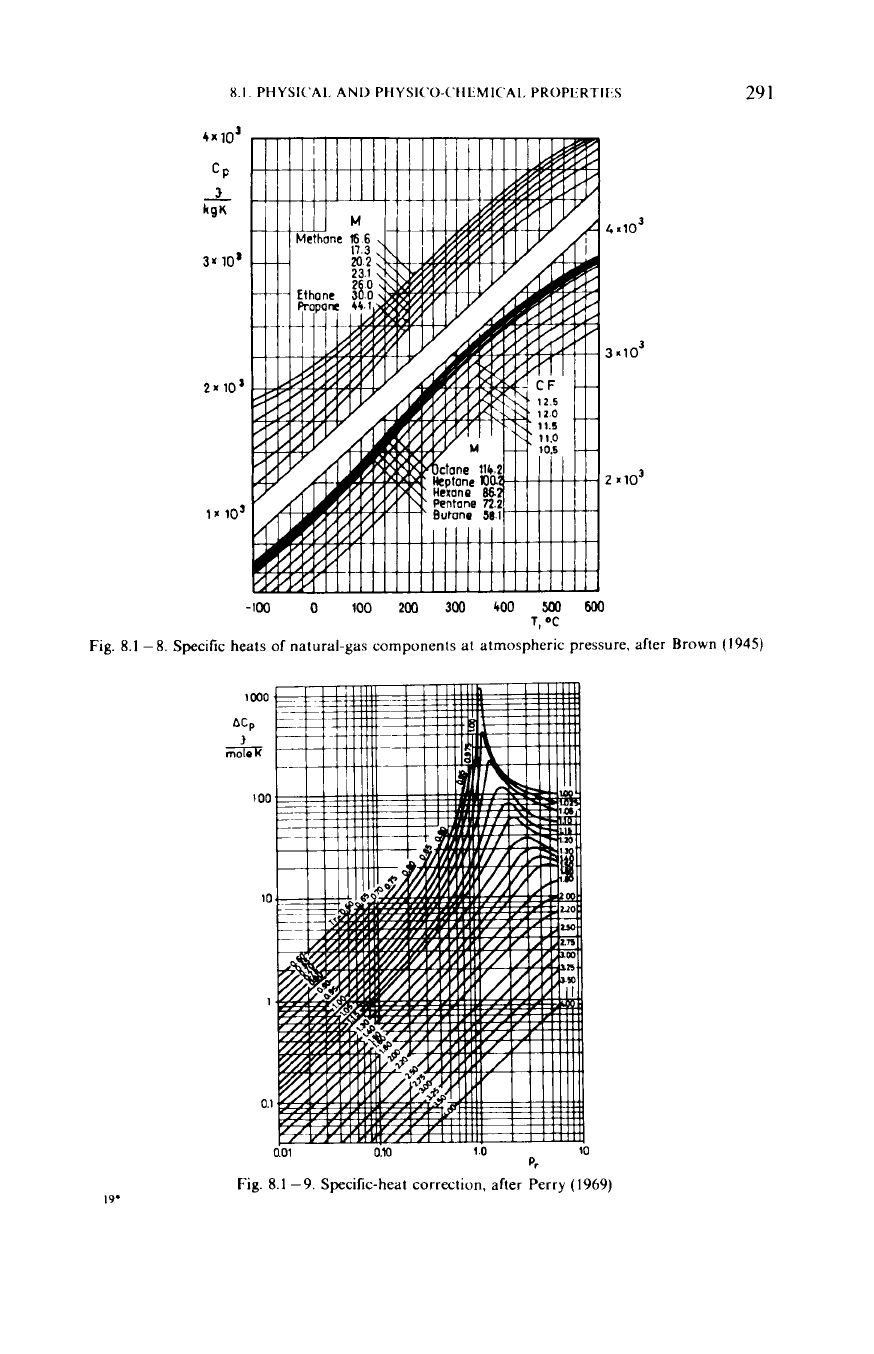
29
1
-100
0
100
ZOO
300
400
500
T,
OC
Fig.
8.1
-8.
Specific heats
of
natural-gas components at atmospheric pressure, after Brown
(1945)
19.
Fig.
8.1
-9.
Specilic-heat correction, after Perry
(1969)
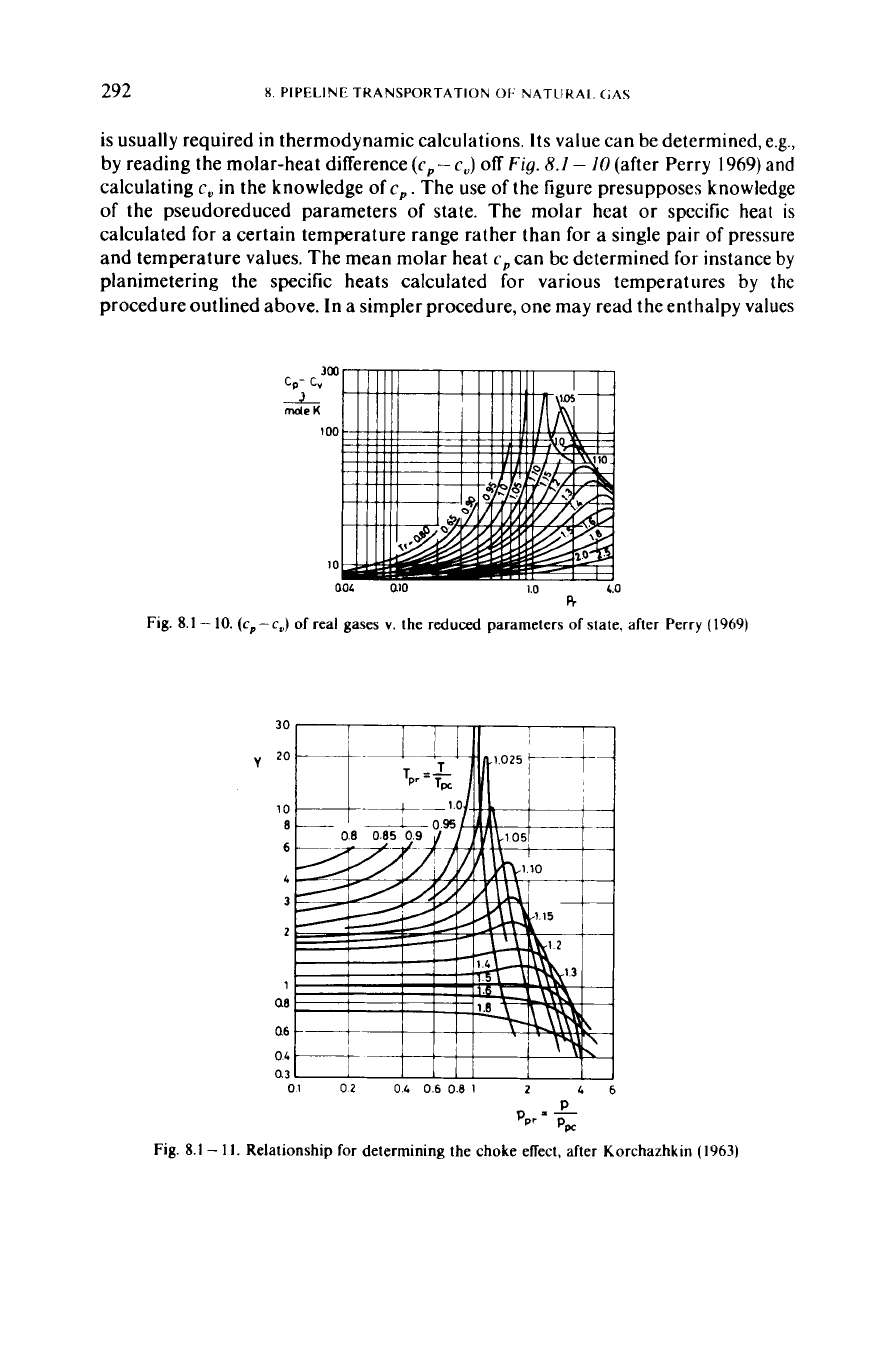
292
8.
PIPELINE TRANSPORTATION
01-
NATURAL.
GAS
is usually required in thermodynamic calculations.
Its
value can be determined, e.g.,
by reading the molar-heat difference
(c,
-
c,)
off
Fig.
8.
I
-
I0
(after Perry
1969)
and
calculating
c,
in
the knowledge of
c,.
The use
of
the figure presupposes knowledge
of the pseudoreduced parameters
of
state. The molar heat
or
specific heat
is
calculated for a certain temperature range rather than for a single pair of pressure
and temperature values. The mean molar heat
c,
can be determined
for
instance by
planimetering the specific heats calculated for various temperatures by
the
procedure outlined above. In a simpler procedure, one may read the enthalpy values
Fig.
8.1
-
10.
(cp-c
300
C"
!K
-
100
I0
OOL
aio
.")
of real gases
v.
the reduced parameters
of
state, after Perry (1969)
30,
I
I
Ill1
I
V
01
02
04
06
0.8
1
2
46
Fig.
8.1
-
1
I.
Relationship for determining the choke effect, after Korchazhkin (1963)
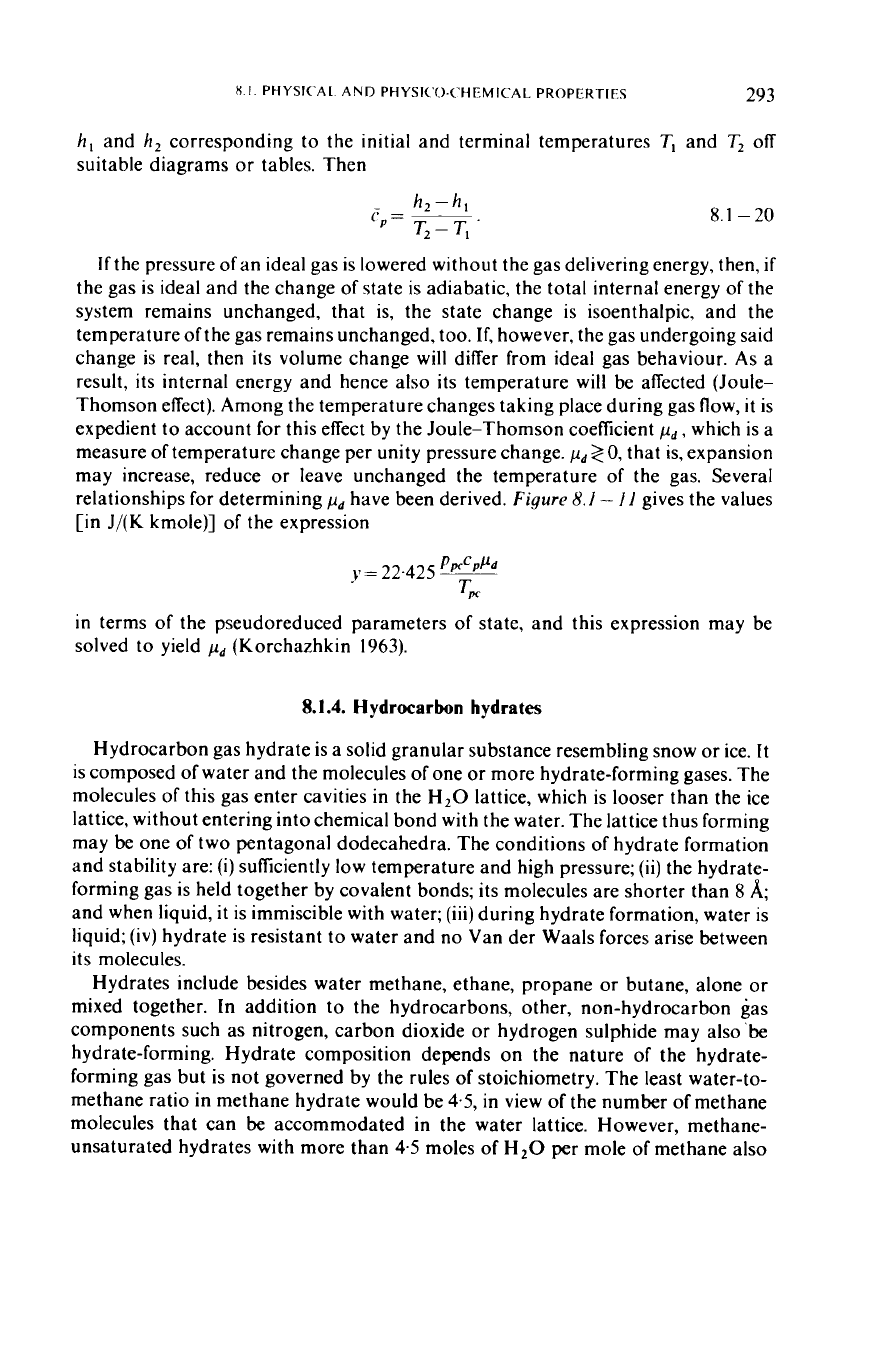
293
X
I
PHYSICAL AND PHYSK'O-CHEMICAL PROPERTIES
h,
and
h,
corresponding to the initial and terminal temperatures
T,
and
T,
off
suitable diagrams or tables. Then
8.1
-
20
If
the pressure of an ideal gas is lowered without the gas delivering energy, then,
if
the gas is ideal and the change of state is adiabatic, the total internal energy of the
system remains unchanged, that is, the state change is isoenthalpic, and the
temperature of the gas remains unchanged, too.
If,
however, the gas undergoing said
change is real, then its volume change will differ from ideal gas behaviour. As a
result, its internal energy and hence also its temperature will be affected (Joule-
Thomson effect). Among the temperature changes taking place during gas flow,
it
is
expedient to account for this effect by the Joule-Thomson coefficient
pd,
which is a
measure of temperature change per
unity
pressure change.
pd
2
0,
that is, expansion
may increase, reduce
or
leave unchanged the temperature of the gas. Several
relationships for determining
pd
have been derived.
Figure
8.1
-
I
I
gives the values
[in
J/(K
kmole)] of the expression
Ppccppd
4'
=
22-425
~
Tw
in
terms of the pseudoreduced parameters of state, and this expression may be
solved to yield
p,,
(Korchazhkin
1963).
8.1.4.
Hydrocarbon hydrates
Hydrocarbon gas hydrate is a solid granular substance resembling snow or ice.
It
is composed of water and the molecules of one
or
more hydrate-forming gases. The
molecules of this gas enter cavities in the H,O lattice, which is looser than the ice
lattice, without entering into chemical bond with the water. The lattice thus forming
may be one of two pentagonal dodecahedra. The conditions of hydrate formation
and stability are:
(i)
sufficiently low temperature and high pressure;
(ii)
the hydrate-
forming gas is held together by covalent bonds; its molecules are shorter than
8
b;;
and when liquid, it is immiscible with water;
(iii)
during hydrate formation, water is
liquid;
(iv)
hydrate is resistant to water and no Van der Waals forces arise between
its molecules.
Hydrates include besides water methane, ethane, propane or butane, alone or
mixed together. In addition to the hydrocarbons, other, non-hydrocarbon gas
components such as nitrogen, carbon dioxide or hydrogen sulphide may also 'be
hydrate-forming. Hydrate composition depends on the nature of the hydrate-
forming gas but is not governed by the rules
of
stoichiometry. The least water-to-
methane ratio in methane hydrate would be
4.5,
in view of the number of methane
molecules that can be accommodated in the water lattice. However, methane-
unsaturated hydrates with more than
4.5
moles of
H,O
per mole of methane also
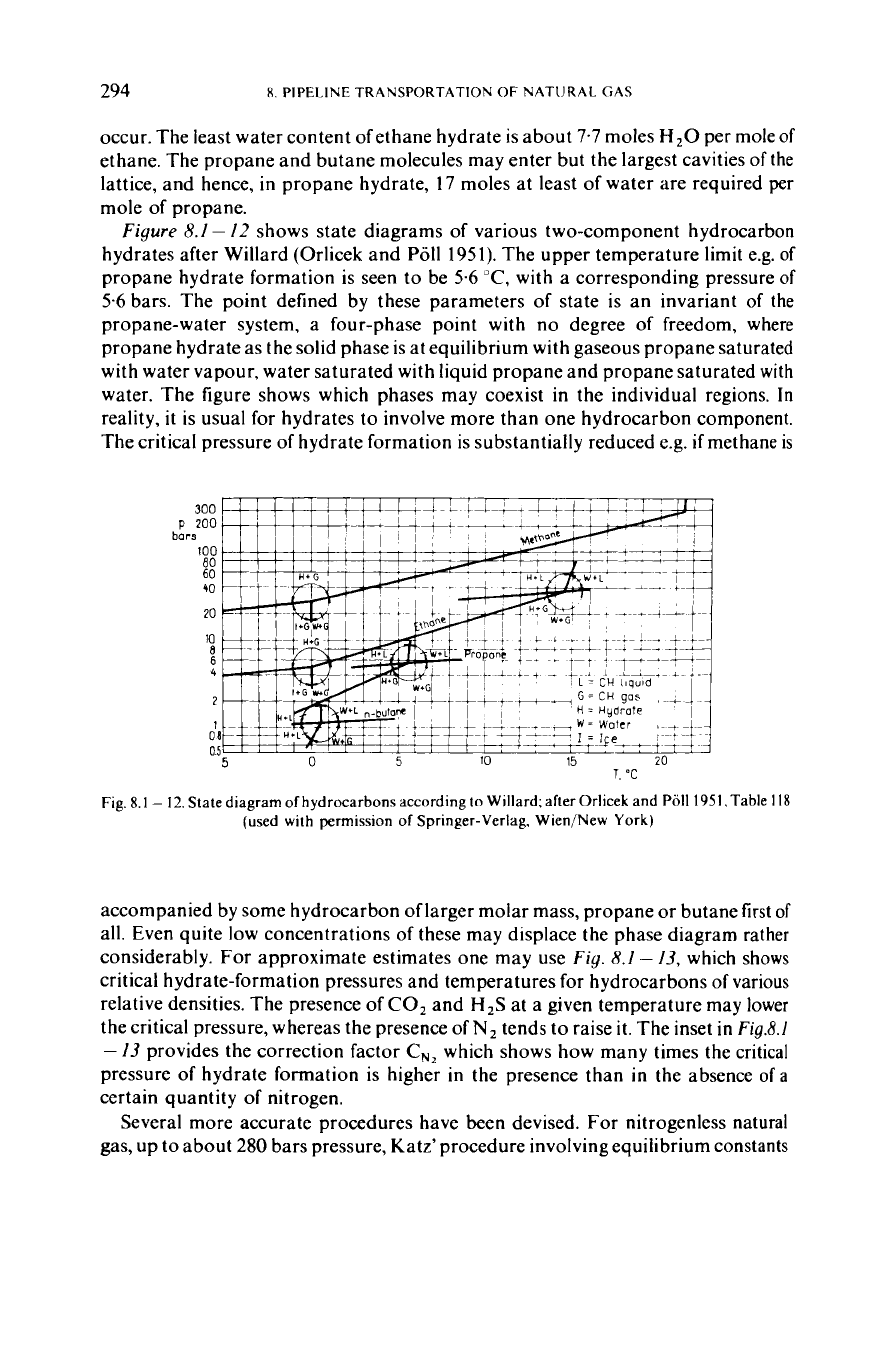
294
X.
PIPELINE
TRANSPORTATION
OF
NATIJRAL GAS
occur. The least water content ofethane hydrate is about
7.7
moles
H,O
per moleof
ethane. The propane and butane molecules may enter but the largest cavities of
the
lattice, and hence, in propane hydrate,
17
moles at least of water are required
per
mole of propane.
Figure
8.1
-
12
shows state diagrams of various two-component hydrocarbon
hydrates after Willard (Orlicek and
Poll
1951).
The upper temperature limit e.g. of
propane hydrate formation is seen to be
56
"C,
with
a corresponding pressure
of
5.6
bars. The point defined by these parameters of state is an invariant of
the
propane-water system, a four-phase point with no degree of freedom, where
propane hydrate as the solid phase is at equilibrium with gaseous propane saturated
with water vapour, water saturated with liquid propane and propane saturated
with
water. The figure shows which phases may coexist in the individual regions.
In
reality,
it
is usual for hydrates to involve more than one hydrocarbon component.
The critical pressure of hydrate formation is substantially reduced e.g.
if
methane
is
300
P
200
100
80
60
40
20
10
8
6
4
2
1
05
bars
oa
5
0
5
10
15 20
T.
"C
Fig.
8.1
-
12.
Statediagram
of
hydrocarbons according to Willard; after Orlicek and
Poll
1951,
Table
I18
(used with permission
of
Springer-Verlag. Wien/New
York)
accompanied by some hydrocarbon of larger molar mass, propane
or
butane first
of
all. Even quite low concentrations of these may displace the phase diagram rather
considerably.
For
approximate estimates one may use
Fig.
8.1
-
13,
which shows
critical hydrate-formation pressures and temperatures for hydrocarbons of various
relative densities. The presence of
CO,
and
H,S
at a given temperature may
lower
the critical pressure, whereas the presence of
N,
tends to raise
it.
The inset
in
Fig.8.1
-
13
provides the correction factor
C,,
which shows how many times the critical
pressure of hydrate formation is higher in the presence than
in
the absence of
a
certain quantity of nitrogen.
Several more accurate procedures have been devised.
For
nitrogenless natural
gas,
up
to about
280
bars pressure, Katz' procedure involving equilibrium constants
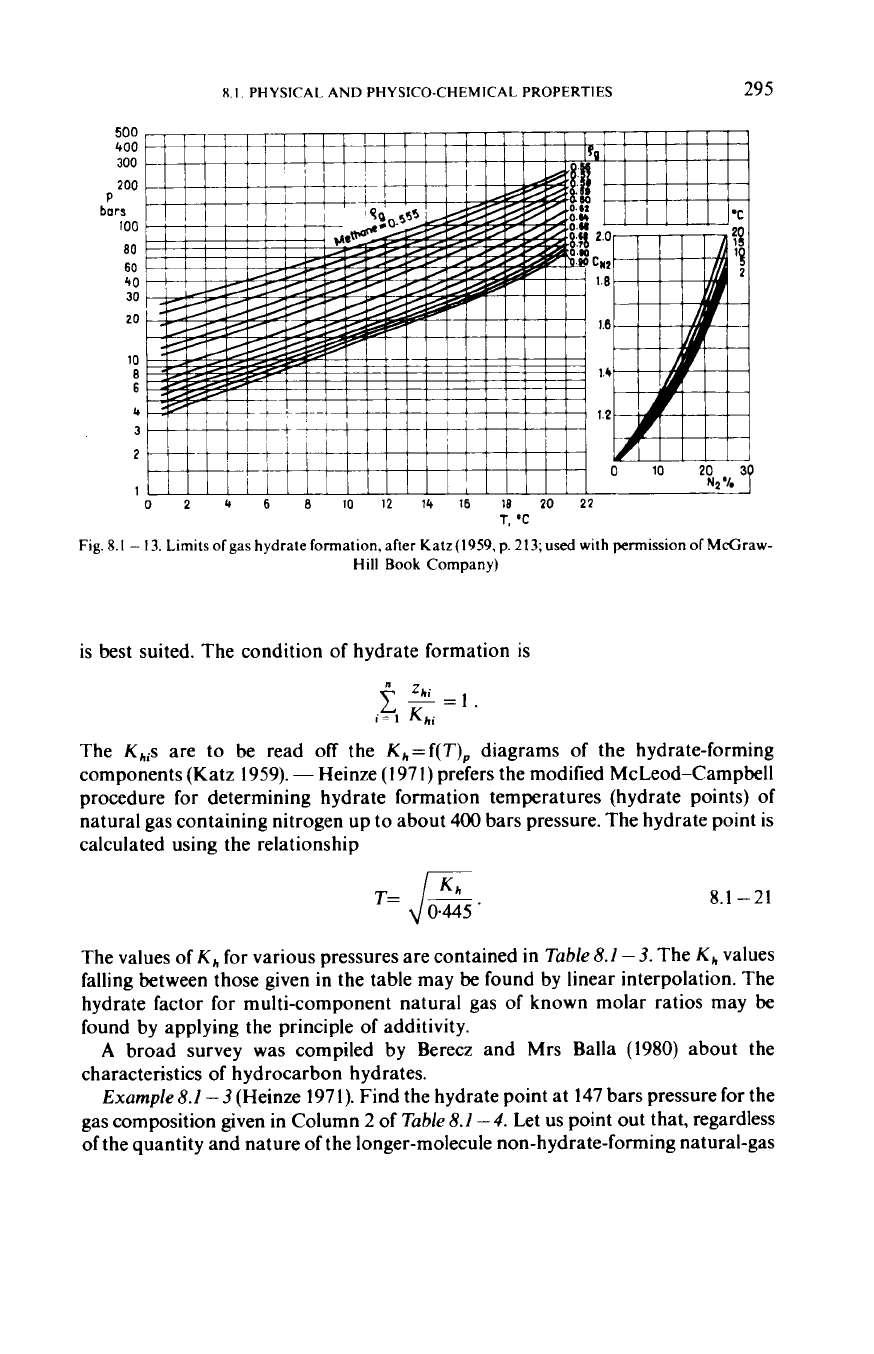
X.I.
PHYSICAL
AND
PHYSICO-CHEMICAL PROPERTIES
295
500
400
300
200
P
bars
100
80
60
40
30
20
10
8
6
1
0
2
4
6
8
10
12
14
16
18
'20
22
T,
*C
Fig.
8.1
-
13.
Limits
of
gas
hydrate formation,
after
Katz(
1959,
p.
213;
used
with permission
of
McGraw-
Hill
Book
Company)
is best suited. The condition of hydrate formation
is
The
Khis
are to be read
off
the Kh=f(T), diagrams of the hydrate-forming
components (Katz
1959).
-
Heinze
(1971)
prefers the modified McLeod-Campbell
procedure for determining hydrate formation temperatures (hydrate points) of
natural gas containing nitrogen up to about
400
bars pressure. The hydrate point is
calculated using the relationship
T=&.
8.1 -21
The values of
Kh
for various pressures are contained in Table
8.1
-3.
The
Kh
values
falling between those given in the table may
be
found by linear interpolation. The
hydrate factor for multi-component natural gas
of
known molar ratios may be
found by applying the principle
of
additivity.
A
broad survey was compiled by Berecz and Mrs Balla
(1980)
about the
characteristics
of
hydrocarbon hydrates.
Example
8.1
-3
(Heinze
1971).
Find the hydrate point at
147
bars pressure for the
gas composition given in Column
2
of Table
8.1
-4.
Let us point out that, regardless
of
the quantity and nature of the longer-molecule non-hydrate-forming natural-gas
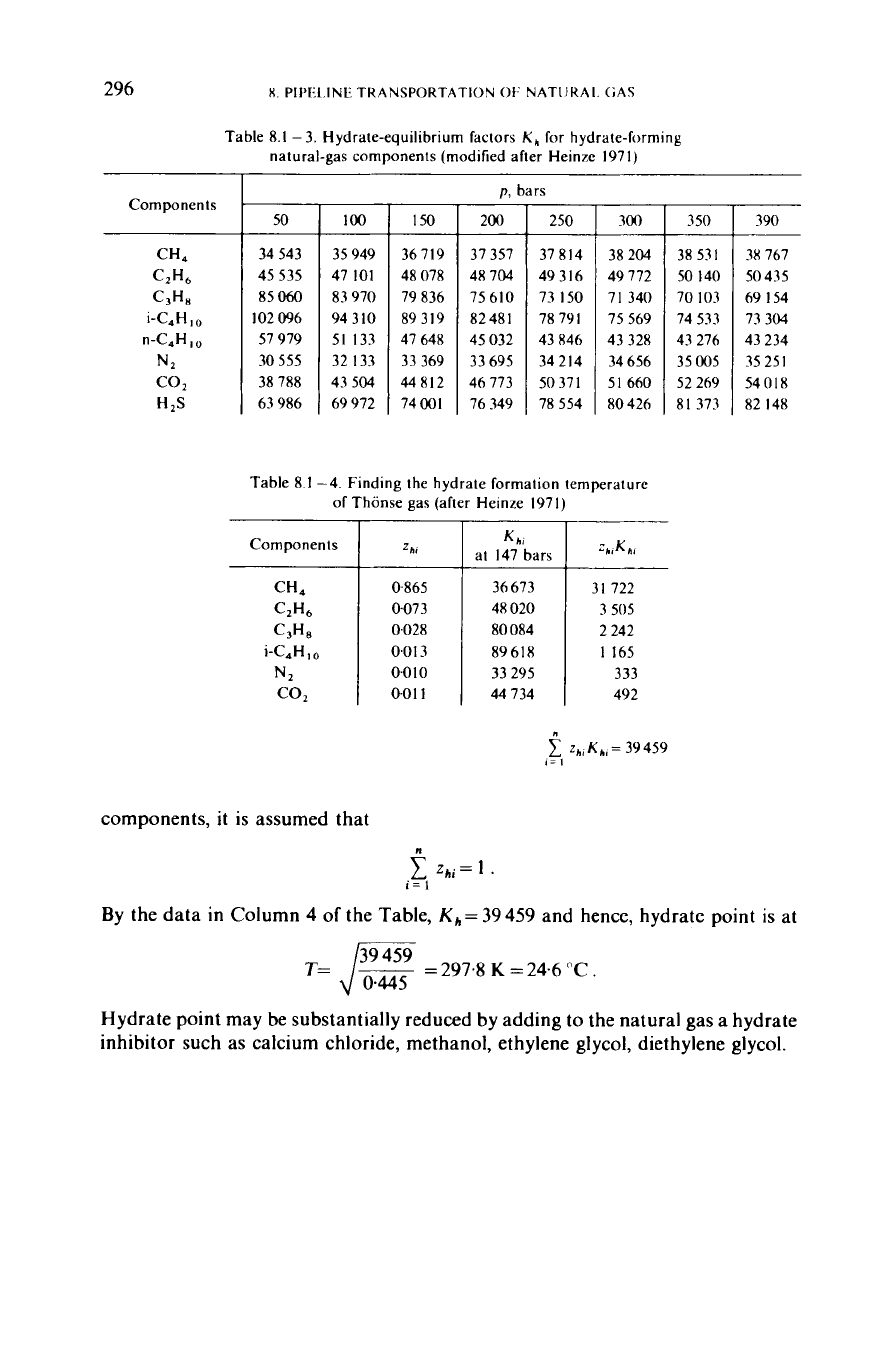
296
X.
PIPIXINE TKANSPORTATION
Of'
NATIIKAI.
GAS
Table
8.1
-
3.
Hydrate-equilibrium factors
Kh
for
hydrate-forming
natural-gas components (modified after Heinze
1971)
Components
50
34
543
45
535
85
060
102 096
57 979
30
555
63 986
38
788
100
35
949
47
101
83 970
94
310
51
133
32
133
43
504
69 972
1
50
36 719
48 078
79 836
47 648
33
369
44x12
74001
89 319
n.
bars
200
37 357
48 704
75 610
82481
45 032
33
695
46 773
76 349
250
37 814
49 316
73 150
78 791
43 846
34214
50371
78
554
300
38
204
49 772
71 340
75 569
43
328
34 656
51
660
80 426
Table
8.1
-4.
Finding the hydrate formation temperature
of
Thonse gas (after Heinze
1971)
Components
zh#
0.865
0.073
0.028
0.01
3
0.010
0.01
1
hi
at
147
bars
36 673
48 020
80 084
89618
33
295
44
734
'hiKhi
31
722
3
505
2
242
1165
333
492
350
38
531
50
140
70
103
74
533
43 276
35
005
52
269
81
373
390
3X
767
50
435
69 154
73 304
43 234
35
251
54018
82 14x
zh,
Kh,
=
39 459
,=I
components,
it
is
assumed that
n
By the data in Column
4
of
the Table, Kh=39459 and hence, hydrate point is at
T=
/%
=
297.8
K
=
24.6 "C
.
Hydrate point may be substantially reduced by adding
to
the natural gas a hydrate
inhibitor such
as
calcium chloride, methanol, ethylene glycol, diethylene glycol.
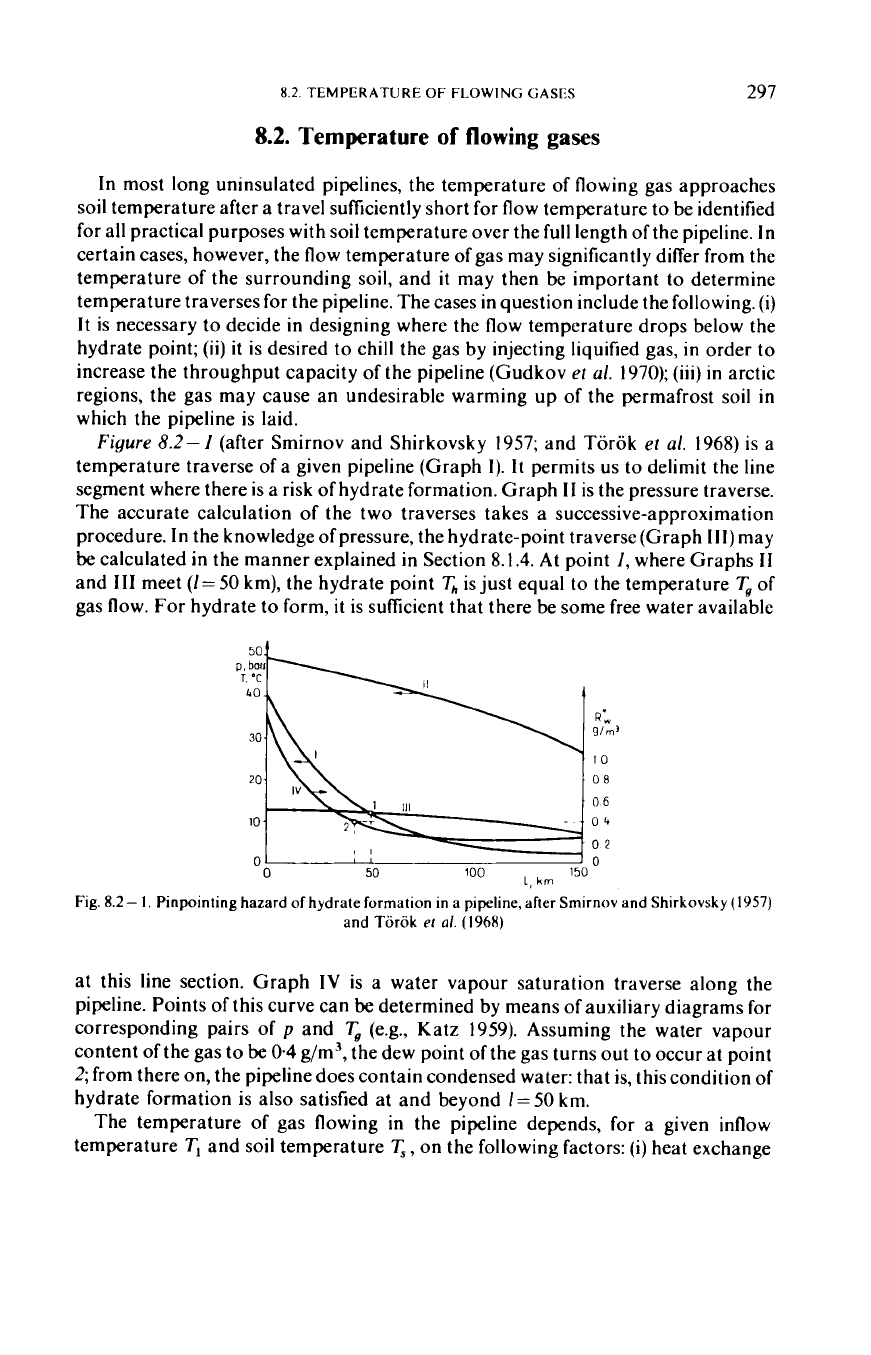
8.2
TEMPERATURE
OF
FLOWING
(;ASIS
297
8.2.
Temperature
of
flowing
gases
In most long uninsulated pipelines, the temperature
of
flowing gas approaches
soil temperature after a travel sufficiently short for flow temperature to be identified
for all practical purposes with soil temperature over the full length of the pipeline.
In
certain cases, however, the flow temperature of gas may significantly differ from the
temperature
of
the surrounding soil, and
it
may then be important to determine
temperature traverses for the pipeline. The cases in question include the following.
(i)
It is necessary to decide in designing where the flow temperature drops below the
hydrate point;
(ii)
it
is desired to chill the gas by injecting liquified gas,
in
order to
increase the throughput capacity of the pipeline (Gudkov
et
ul.
1970);
(iii)
in
arctic
regions, the gas may cause an undesirable warming up of the permafrost soil
in
which the pipeline is laid.
Figure
8.2-
I
(after Smirnov and Shirkovsky 1957; and Torok
et
al.
1968)
is a
temperature traverse of a given pipeline (Graph
I).
It
permits
us
to delimit the line
segment where there is a risk of hydrate formation. Graph
I1
is the pressure traverse.
The accurate calculation
of
the two traverses takes a successive-approximation
procedure. In the knowledge
of
pressure, the hydrate-point traverse (Graph
111)
may
be
calculated in the manner explained in Section
8.1.4.
At
point
I,
where Graphs
I1
and
I11
meet
(I=50
km), the hydrate point
&
is just equal to the temperature
T,
of
gas flow.
For
hydrate
to
form,
it
is sufficient that there be some free water available
Fig.
8.2-
1.
Pinpointing hazard
of
hydrate formation in
a
pipeline, after Srnirnov and Shirkovsky
(1957)
and Tiirok
et
a/.
(1968)
at this line section. Graph
IV
is a water vapour saturation traverse along the
pipeline. Points of this curve can
be
determined by means
of
auxiliary diagrams for
corresponding pairs of
p
and
T,
(e.g., Katz
1959).
Assuming the water vapour
content of the
gas
to
be
04
g/m3, the dew point of the gas turns out to occur at point
2;
from there on, the pipeline does contain condensed water: that is, this condition of
hydrate formation is also satisfied at and beyond
1
=
50
km.
The temperature of gas flowing in the pipeline depends, for a given inflow
temperature
TI
and soil temperature
K,
on the following factors:
(i)
heat exchange
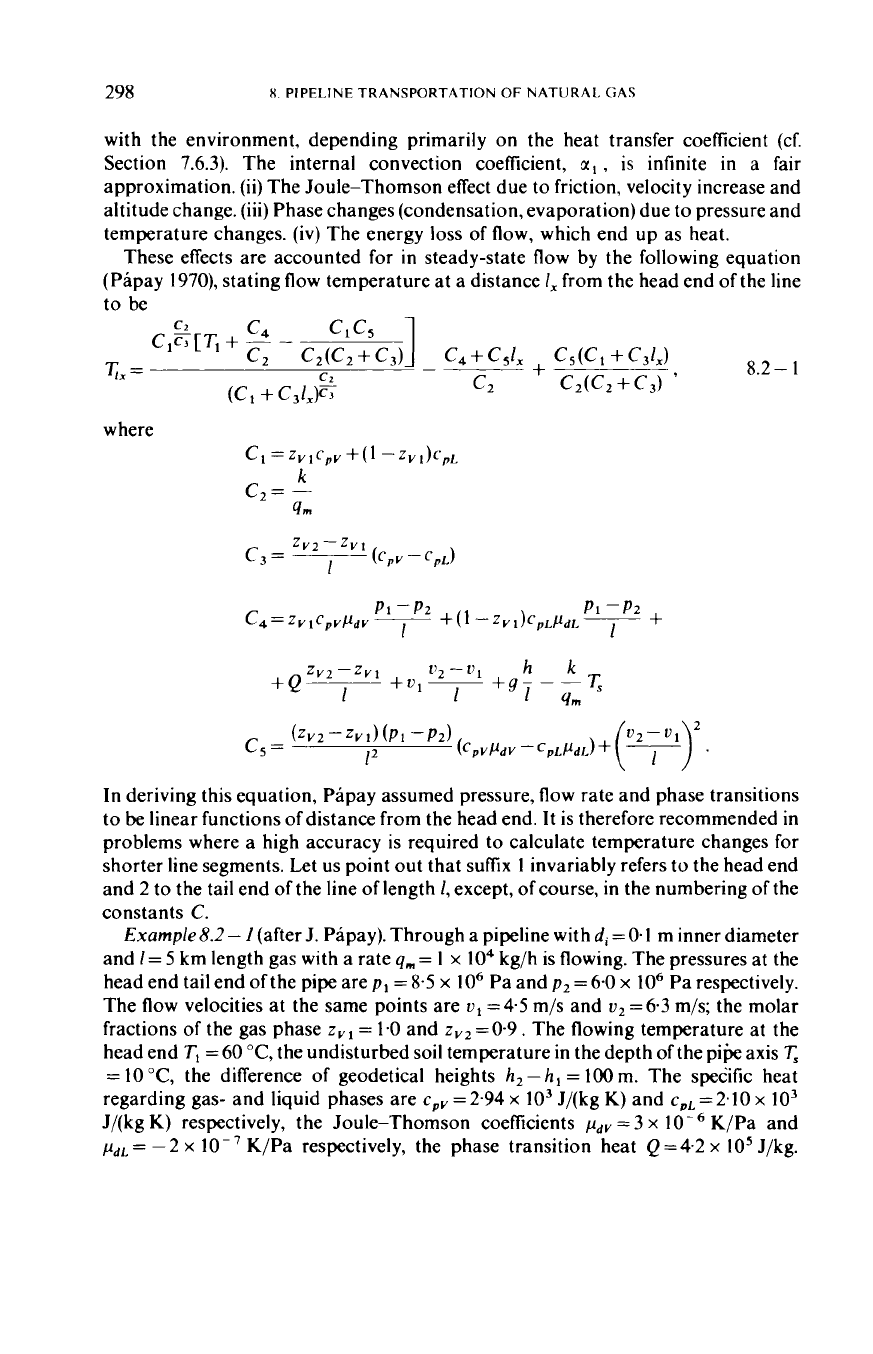
298
X.
PIPELINE TRANSPORTATION
OF
NATURAL.
GAS
with the environment, depending primarily on the heat transfer coefficient (cf.
Section
7.6.3).
The internal convection coefficient,
xl,
is infinite
in
a fair
approximation.
(ii)
The Joule-Thomson effect due to friction, velocity increase and
altitude change.
(iii)
Phase changes (condensation, evaporation) due
to
pressure and
temperature changes.
(iv)
The energy loss of flow, which end up as heat.
These effects are accounted for in steady-state flow by the following equation
(Papay
1970),
stating flow temperature at a distance
I,
from the head end of the line
to be
k
c2=
-
Ym
In deriving this equation, Papay assumed pressure, flow rate and phase transitions
to
be
linear functions
of
distance from the head end. It is therefore recommended in
problems where a high accuracy is required to calculate temperature changes for
shorter line segments. Let us point out that suffix
1
invariably refers to the head end
and
2
to the tail end
of
the line
of
length
I,
except, of course, in the numbering of the
constants
C.
Example
8.2
-
I
(after J. Papay). Through a pipeline with
di
=
0
1
m inner diameter
and
1
=
5
km length gas with a rate
qm
=
1
x
lo4 kg/h is flowing. The pressures at the
head end tail end of the pipe are
p1
=
8.5
x
lo6
Pa and
p2
=
6-0
x
lo6
Pa respectively.
The flow velocities at the same points are
u1
=4.5
m/s and
v2
=
6.3
m/s; the molar
fractions
of
the gas phase
zvl
=
1.0
and
zv2
=0-9.
The flowing temperature at the
head end
Tl
=
60
"C,
the undisturbed soil temperature in the depth of the pi+ axis
T,
=
10
"C,
the difference of geodetical heights
h,
-
h,
=
100
m. The specific heat
regarding gas- and liquid phases are
cpv
=
2.94
x
lo3
J/(kg K) and
cPL
=
2.10
x
lo3
J/(kg K) respectively, the Joule-Thomson coefficients
pdv
=
3
x
K/Pa and
pdL=
-2
x
lo-' K/Pa respectively, the phase transition heat
Q=4.2
x
lo5
J/kg.

X.2.
TEMPERATURE
OF
FLOWING
GASES
299
Let
us
calculate the temperature at the tail end of the pipeline with Equation
8.2
-
1,
a) taking into account all therms
of
this equation,
b)
neglecting the Joule-
Thomson effect, c) neglecting the effect
of
change in velocities, d) supposing the pipe
is horizontal, e) neglecting the effect of condensation.
The result of the calculation is listed as follows:
calculated value
of
T2 in
"C
case characteristics
a
all terms
34.7
c
u1
=u2
34.7
e
Q=O
25.2.
h
/&v=o;
kL=O
39.4
d
h,
=
h,
34.9
It is visible, that in this case the effect
of
the change in velocities and heights is
negligible but the impact
of
the Joule-Thomson effect and phase transition is
considerable.
In the case when the phase changes are left out of consideration
-
that is,
in
single-phase
flow
-
Eq.
8.2-
1
simplifies
to
8.2
-
2
where
k
qmcpv
The first two terms
of
this equation describe heat exchange with the environment;
the third one accounts for the Joule-Thomson effect, the fourth for the change
in
geodetic head and the fifth for the change in velocity head. In practical calculations,
the last two terms may be neglected. The resulting error is usually less than the error
due to uncertainties in the various parameters.
If
the pressure drop is small, then
so
is the temperature drop to expansion, and the third term may also be neglected, in
which case Eq.
8.2
-
2
simplifies to Eq.
7.6
-
15.
a=
__
